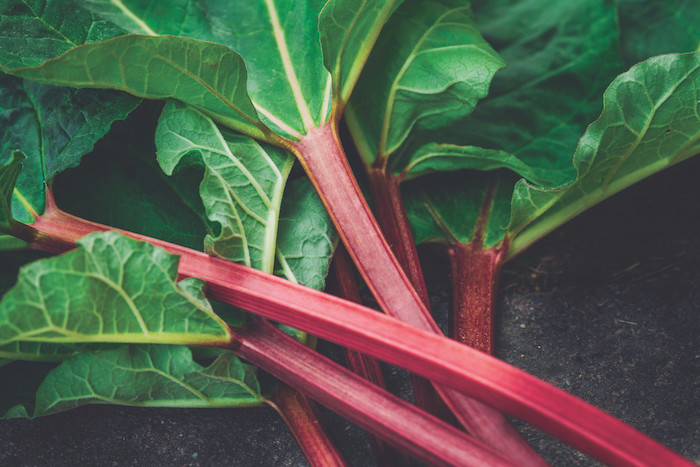
As the season’s bounty becomes apparent across parks, woodlands and verges, the garden offers a chance to flirt with early emerging and versatile rhubarb. Anistatia Miller & Jared Brown have the perfect pairings.
Rhubarb is one of those quintessential English flavours. Culinary rhubarb, that is. There are other members of the rhubarb family imported from China that are strictly consumed for medicinal purposes. Don’t worry – they don’t get accidentally sold in markets or garden centres. The ruby red rhubarb we are talking about first arrived on English shores around the late 1600s when the East India Company imported it. Since then, English horticulturists have developed new strains that were suitable for forcing to obtain a crop as early as February (although you don’t want to do this every year to your rhubarb crowns as it depletes their energy rapidly and they die).
When these ruby red stalks emerge from their bulbous crowns, it’s as much a sign of spring as the first avalanches of snowdrops and daffodils that cascade along the verges. We’ve had the same two Timperley Early rhubarb crowns growing in our garden for seven years. Every spring, they deliver their beautiful tartness and deep ruby hue for us to enjoy without forcing them. This might be the year when they die back; we’ll split them and transplant the divided crowns to give them new life. Aside from that, they’ve never needed more than sun and water and a cut-and-come-again attitude toward harvesting. This vegetable is such an all-rounder in the kitchen and in the bar that it’s hard to know where to start with suggestions for its use.
So, let’s start simple. Rhubarb cordial is the quickest non-alcoholic ingredient you can fix up. Chop up rhubarb stalks and a slice of fresh ginger too. The zests and juices of an orange and a lemon add a citrusy sweetness. Put 300ml water and 300g of golden caster sugar in a saucepan and bring to a simmer. Add the ginger, citruses and rhubarb. Continue to simmer and occasionally stir until the rhubarb falls apart into stringy strands. Cool and strain through a sieve, then bottle in sterilised bottles. Sparkling water, 25ml of gin and 25ml of rhubarb cordial, topped with a sprig of mint in a glass with a few cubes of ice, welcomes in spring in style.
Two-pronged approach
In this household, we have two ways of making rhubarb gin. Jared simmers his chopped-up rhubarb with water and caster sugar to make a sloppy syrup that he strains and blends with gin. Sometimes he adds spring raspberries or strawberries in the cooking process to enhance the colour and the aroma. He’s even been known to make a cheeky rhubarb Irish whiskey using the same method.
I tend to cook my rhubarb in a roasting tin with a split vanilla pod and a healthy sprinkle of caster sugar. I cover the tin tightly with foil, roast, and leave it to rest after it’s cooked for about 30-40 minutes. Leave the tin covered while you let it cool down, allowing the juices to extract on their own. Finally, I strain the resulting syrup and add the gin.
Both methods are delicious and the upside is that you can eat the leftover mash from either version spooned over yogurt or ice cream. But that’s not the end of the story with rhubarb gin, or rhubarb tequila, or rhubarb any spirit for that matter.
There’s another way to make a rhubarb spirit that takes its flavour from raw rhubarb. However, this method makes you wait for about a month before you can savour its tartness. In a large container with a lid, put 1kg of chopped rhubarb and 400g of golden caster sugar. Shake it up. Close the jar and keep it in a dark place for 24 hours. Add 700ml of spirit and let the mixture infuse for about four weeks in a dark place. When ready, decant what you want to use immediately out of the jar. Don’t bother to strain; it will only get better for at least another week or two.
But have you considered the possibility of making a rhubarb jam with vanilla pods and jam sugar? This technique not only adds a lovely texture to a shaken cocktail, it improves the shelf life of this springtime ingredient – by up to a year. Or how about making a rhubarb & ginger sorbet to add a creamier texture to a shaken drink?
There are plenty of variations on making rhubarb bitters available online these days that combine such delightful combinations as grapefruit and orange peel, or cardamom and coriander, or cinnamon and juniper berries, each enhanced with chips of cinchona bark, angelica root, and some dried florals such as chamomile or lavender. With rhubarb as a base, any combination of botanicals that tickles your fancy can be married with a high-proof white or brown spirit to give you an aromatic hit that finishes off any springtime drink with a deeply satisfying brightness.
Have we given you enough food for thought to start the spring growing and drinking season? Back to the garden and the new greenhouse


